10° bienal do mercosul
Porto Alegre, Brazil
(Portuguese text below the images)
Extracts of the texts by the curator Gaudêncio Fidelis for the 10th Mercosul Biennial – Messages of a New America (2015), about Lucas Simões’ work Engessados (Plastered) that was part of the section Dust and the World of Objects
Messages from a New America and the genealogy of a cultural platform
(page 221)
The work of Lucas Simões (1980), Engessados [Plastered] (2014), is equally a series of plaster forms, referring to the internal part of the folds in Lygia Clark’s Bichos [Animais], reproduced from their negatives. The pieces are exhibited over an abrasive table and, when manipulated, suffer abrasion and become dust, resulting in their complete disappearance. The participatory aspect of the work promotes a critic to the museologization of the artistic production, especially in the case of Lygia Clark. However, this “interiority” of Lygia’s work, part of this vocation to build form, is not here just a formal reproduction of the negative demonstrated by her Bichos. It is an investigation of the interiority under the perspective of the freezing of movement, taking the experience field to a relation of progressive loss through the abrasion.
Smell and dust as models of cultural contamination
(page 241)
The exhibitions Dust and the World of Objects and Olfactory: Smell in Art needed to deal with the inclusion of a large group of works on the same space, since the coexistence of them through juxtaposition was necessary and, also, materially problematic. However, it was precisely such characteristic that transformed these platforms in some of the most challenging on the 10th Mercosul Biennial, keeping in mind that it tested the limits of coexistence, as mentioned, necessary, between a work and others, or between one and many that problematized the exhibition space. One of such examples is the work
Engessados [Plastered] (2014), by Lucas Simões (1980), in which several pieces of plaster over a table must be manipulated by the viewers, suffering a detrition that generates a dense amount of dust that spreads to the surroundings. It is worth remembering that, even in the most controlled environment, small particles of dust gravitate the space, crossing the air and eventually landing over the surface, only to be displaced again when a sudden movement caused by air forces them to move. It is precisely this dissipation of dust that highlights in this work its greatest interest, since it is preferable for it not to be isolated, ensuring its existence in space as a work without extra requirements, or other devices, for its exhibition. This process of material contamination interferes conceptually in the reading of the other, whether it is by addition or by subtraction. Cultural contamination is a strategic device in exhibitions that intend on expanding the limits of the meaning of works, revealing the conceptual meanders of its existence in the universe of culture, and re defining the materiality of the artistic object in its symbolic potential. There is still another aspect that is put to text through contamination: the canonical status of the work and its capacity of resisting the forays that test the limits of canonicity and the recurrent standards of management of the policies of formation and the establishment of the artistic canon. We may characterize the functioning of contamination as a strategy put in course by a juxtaposition mechanism that, by establishing a confrontation between works, displaces temporarily the meaning for beyond its circumscription. This displacement may produce temporary or lasting effects, both being of importance, because they add new reading possibilities for the work and represent an opening field for rethinking its importance in a specific model of exhibition. Contamination is, thus, a process of “strategic visibility’’ that redefines the status of intervention of the work with the intention of rearticulating the perimeter of the artistic experience by the viewer as producers of knowledge also through him/her.
(Portuguese text below the images)
Extracts of the texts by the curator Gaudêncio Fidelis for the 10th Mercosul Biennial – Messages of a New America (2015), about Lucas Simões’ work Engessados (Plastered) that was part of the section Dust and the World of Objects
Messages from a New America and the genealogy of a cultural platform
(page 221)
The work of Lucas Simões (1980), Engessados [Plastered] (2014), is equally a series of plaster forms, referring to the internal part of the folds in Lygia Clark’s Bichos [Animais], reproduced from their negatives. The pieces are exhibited over an abrasive table and, when manipulated, suffer abrasion and become dust, resulting in their complete disappearance. The participatory aspect of the work promotes a critic to the museologization of the artistic production, especially in the case of Lygia Clark. However, this “interiority” of Lygia’s work, part of this vocation to build form, is not here just a formal reproduction of the negative demonstrated by her Bichos. It is an investigation of the interiority under the perspective of the freezing of movement, taking the experience field to a relation of progressive loss through the abrasion.
Smell and dust as models of cultural contamination
(page 241)
The exhibitions Dust and the World of Objects and Olfactory: Smell in Art needed to deal with the inclusion of a large group of works on the same space, since the coexistence of them through juxtaposition was necessary and, also, materially problematic. However, it was precisely such characteristic that transformed these platforms in some of the most challenging on the 10th Mercosul Biennial, keeping in mind that it tested the limits of coexistence, as mentioned, necessary, between a work and others, or between one and many that problematized the exhibition space. One of such examples is the work
Engessados [Plastered] (2014), by Lucas Simões (1980), in which several pieces of plaster over a table must be manipulated by the viewers, suffering a detrition that generates a dense amount of dust that spreads to the surroundings. It is worth remembering that, even in the most controlled environment, small particles of dust gravitate the space, crossing the air and eventually landing over the surface, only to be displaced again when a sudden movement caused by air forces them to move. It is precisely this dissipation of dust that highlights in this work its greatest interest, since it is preferable for it not to be isolated, ensuring its existence in space as a work without extra requirements, or other devices, for its exhibition. This process of material contamination interferes conceptually in the reading of the other, whether it is by addition or by subtraction. Cultural contamination is a strategic device in exhibitions that intend on expanding the limits of the meaning of works, revealing the conceptual meanders of its existence in the universe of culture, and re defining the materiality of the artistic object in its symbolic potential. There is still another aspect that is put to text through contamination: the canonical status of the work and its capacity of resisting the forays that test the limits of canonicity and the recurrent standards of management of the policies of formation and the establishment of the artistic canon. We may characterize the functioning of contamination as a strategy put in course by a juxtaposition mechanism that, by establishing a confrontation between works, displaces temporarily the meaning for beyond its circumscription. This displacement may produce temporary or lasting effects, both being of importance, because they add new reading possibilities for the work and represent an opening field for rethinking its importance in a specific model of exhibition. Contamination is, thus, a process of “strategic visibility’’ that redefines the status of intervention of the work with the intention of rearticulating the perimeter of the artistic experience by the viewer as producers of knowledge also through him/her.
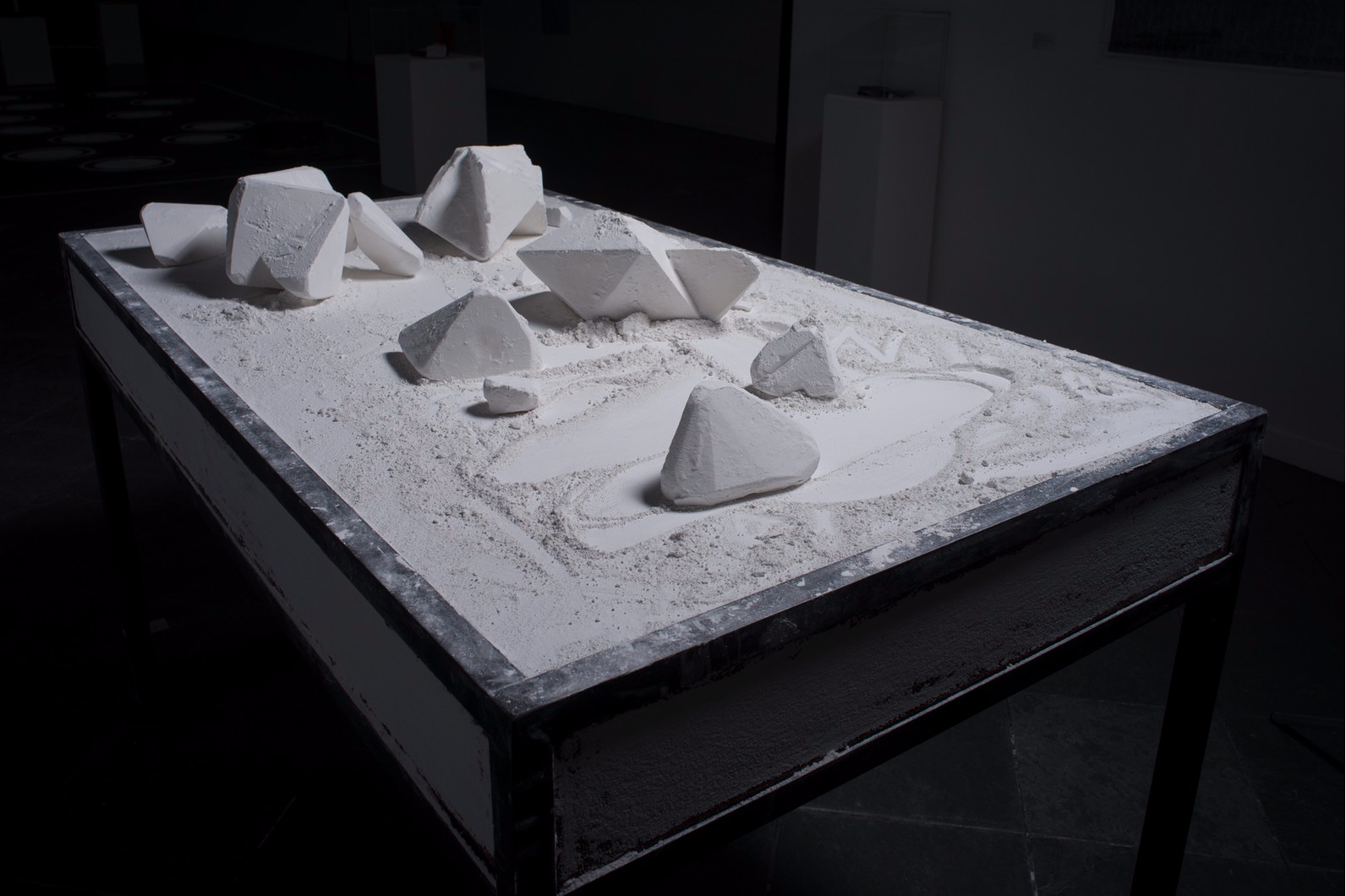

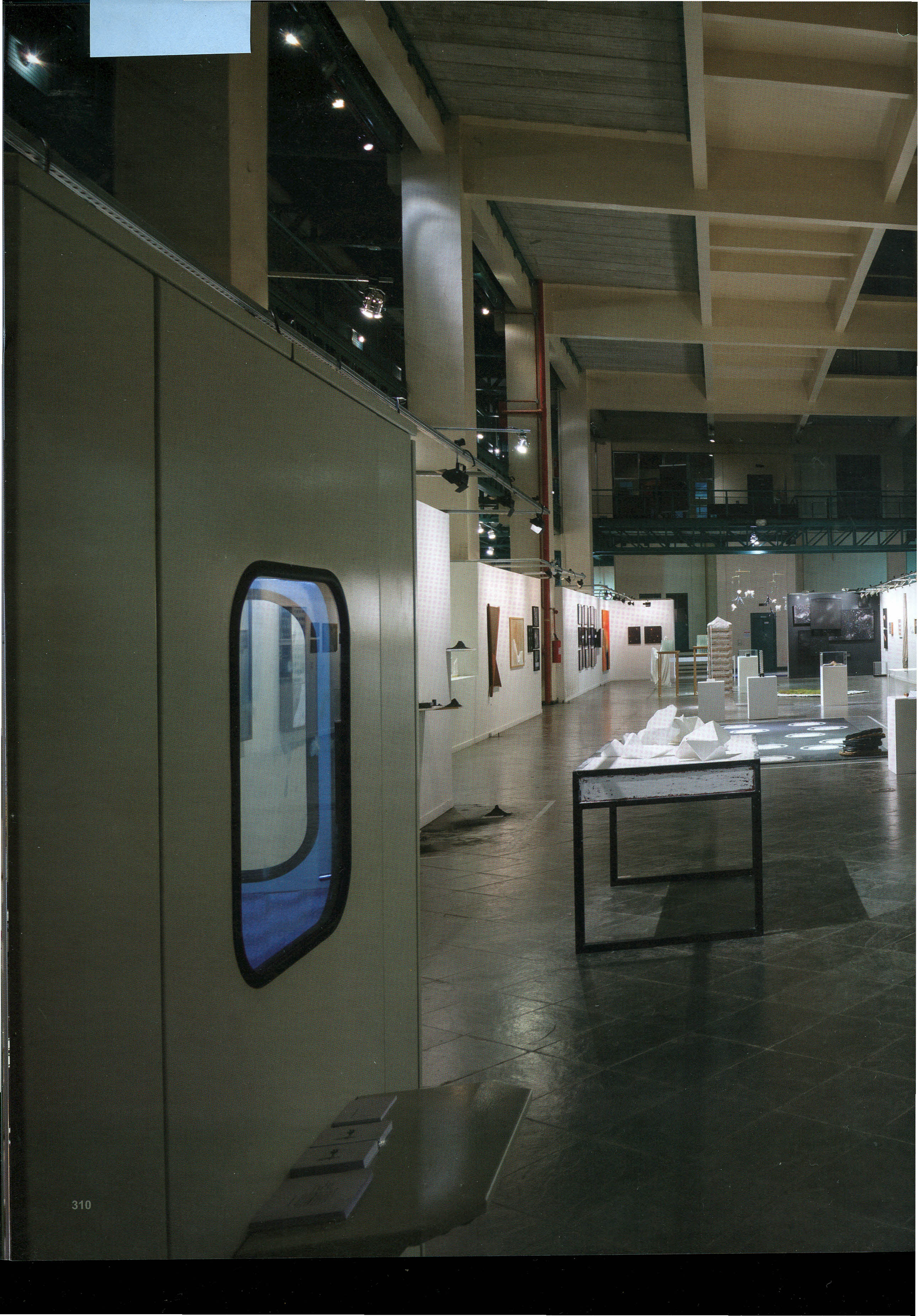
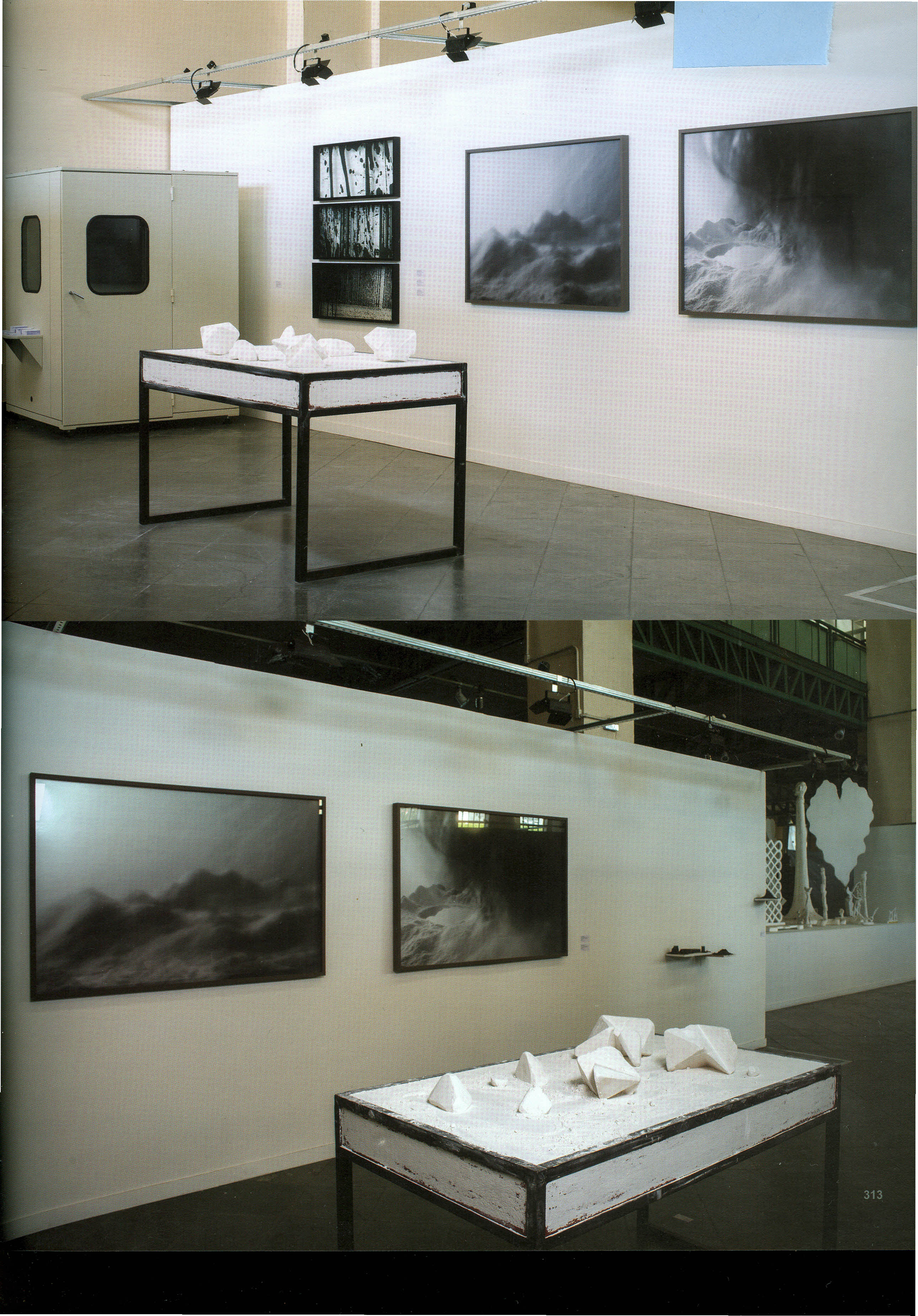
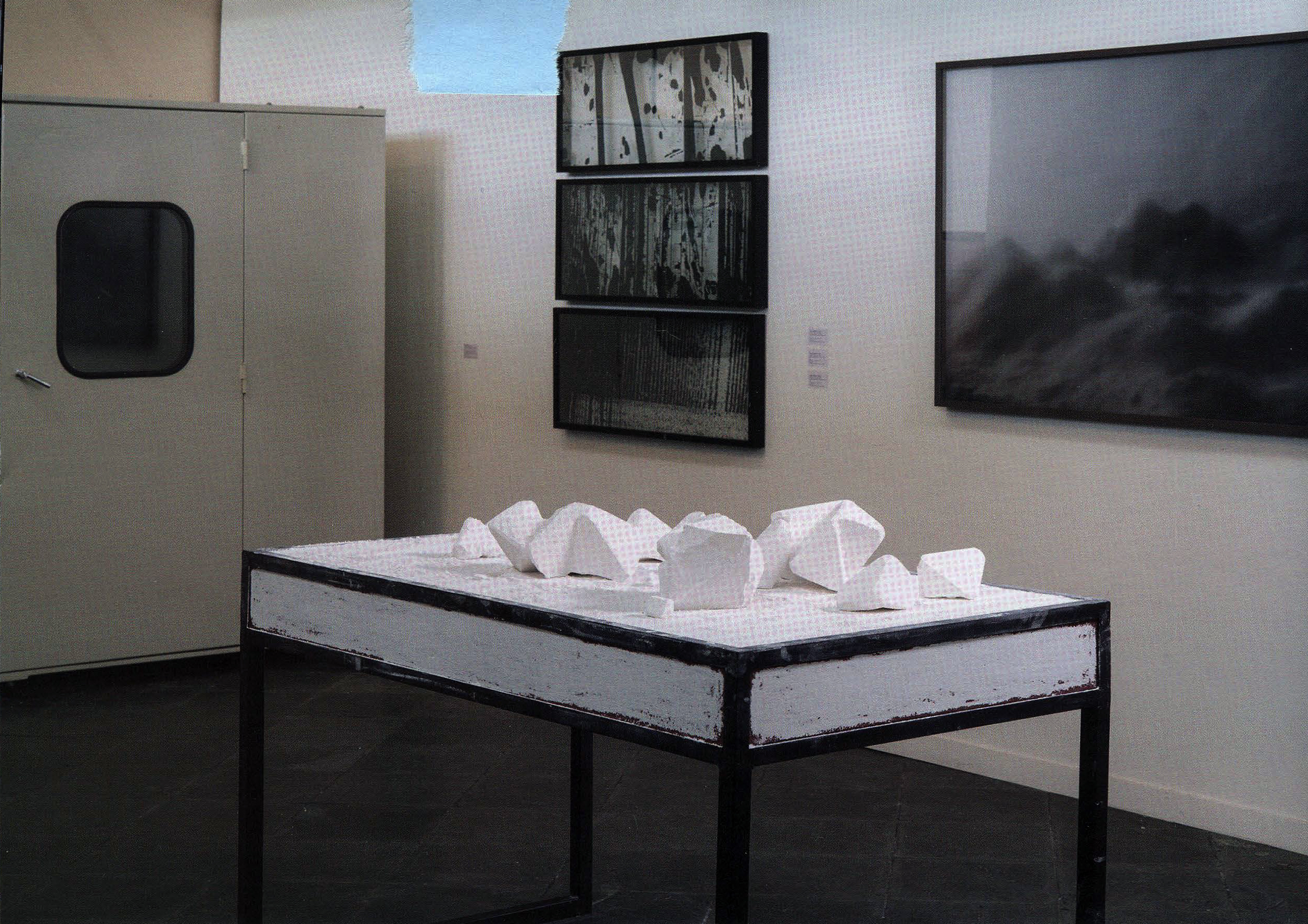

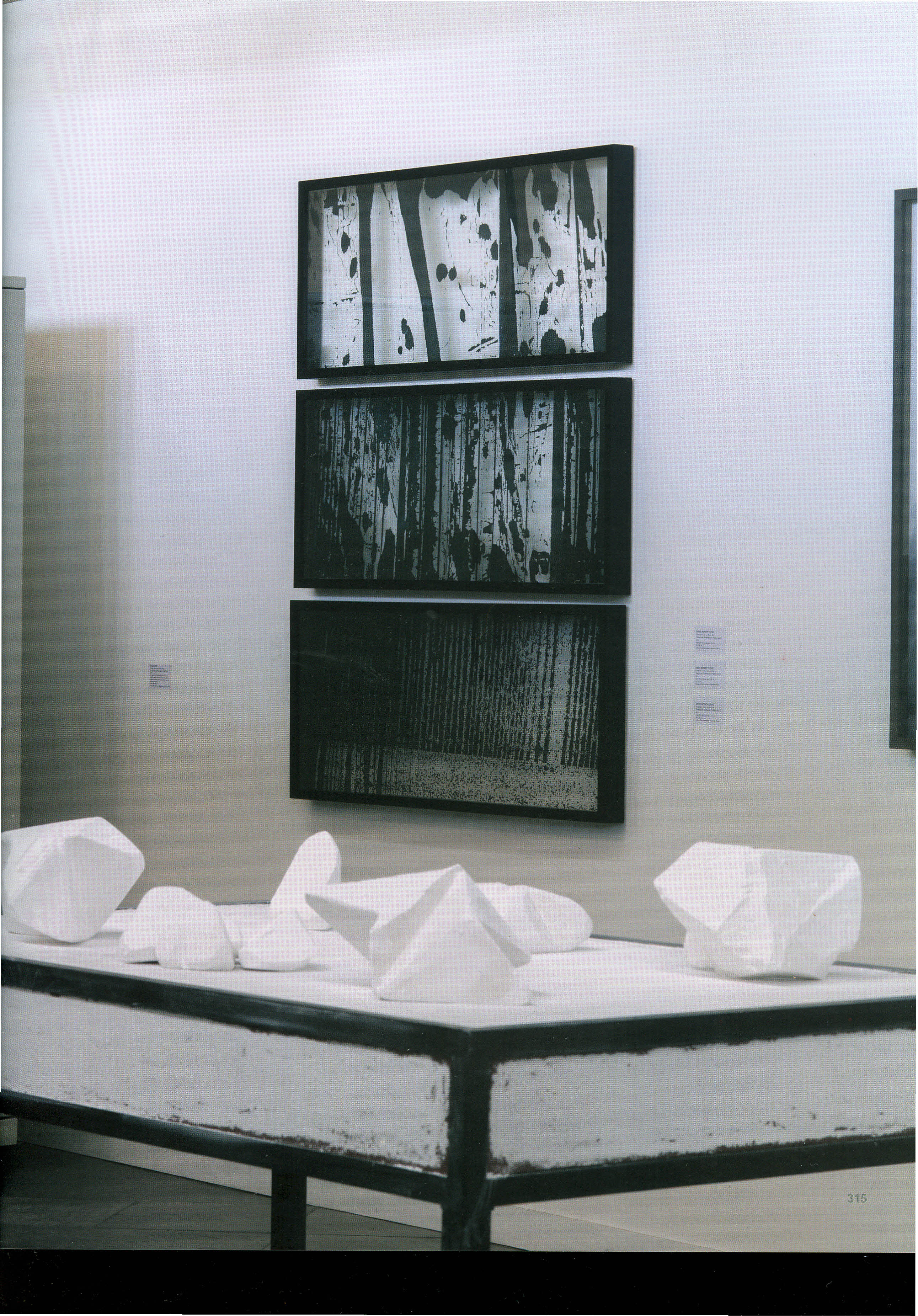
images of the exhibition, Porto Alegre, Brazil, 2015
Textos em português
Trechos dos textos do curador Gaudêncio Fidelis para a 10ª Bienal do Mercosul – Mensagens de uma nova América (2015) , sobre a obra Engessados (2014) de Lucas Simões que fez parte da seção A Poeira e o Mundo dos Objetos.
Mensagens de uma nova América e a genealogia de uma plataforma cultural
(pag. 127)
A obra de Lucas Simoes (1980), Engessados (2014), é igualmente uma série de formas em gesso, remontando a parte interna das dobras dos bichos de Lygia Clark, reproduzidas pelo seu negativo. As peças são exibidas sobre uma mesa abrasiva e, ao sofrerem manipulação, vão se desgastando e transformando-se em poeira, resultando em seu completo desaparecimento. O caráter participativo da obra promove uma crítica a museologização da produção artística, especialmente no caso de Lygia Clark. Entretanto essa “interioridade” da obra de Lygia, parte dessa vocação para construir a forma, não é aqui apenas uma reprodução formal do negativo que seus Bichos demonstram. Trata-se de uma investigação da interioridade sob a perspectiva do congelamento do movimento, levando o campo da experiência a uma relação de perda progressiva pelo desgaste e a consciência de sua efemeridade. Assim, Engessados deixam de estar conformados ao, igualmente, “congelamento” museológico, e pelas mãos do espectador transformam-se eles mesmos em pó, numa manifestação metafórica que redefine a condição material desta obra, uma vez que seu caráter participativo e a razão de seu próprio desaparecimento.
O cheiro e a poeira como modelos de contaminação cultural
(pag. 238)
As exposições A Poeira e o Mundo dos Objetos e Olfatória: O / Cheiro na Arte precisaram tratar da inclusão de um vasto conjunto de obras em um mesmo espaço, visto que a convivência delas por meio de justaposição era necessária e, também, materialmente problemática. Mas foi justamente tal característica que transformou essas plataformas em duas das mais desafiadoras da 10ª Bienal do Mercosul, tendo em vista que elas testavam os limites de convivência, como se disse necessária, entre uma obra e outra ou entre uma e várias que lhe problematizavam o espaço de exposição. Um desses exemplos é a obra Engessados (2014), de Lucas Simões (1980), na qual diversas peças de gesso sobre uma mesa devem ser manipuladas pelo público, sofrendo um desgaste que gera uma densa quantidade de poeira que se espalhapelo entorno.
Vale lembrar que, mesmo no mais controlado dos ambientes, pequenas partículas de pó gravitam pelo espaço, trafegando através do ar e eventualmente pousando sobre uma superfície, apenas para se deslocar novamente quando algum movimento brusco ocasionado pelo ar faz com que elas se movam. É precisamente essa dissipação da poeira que destaca nessa obra seu maior interesse, uma vez que é preferível que ela não esteja isolada, garantindo-se sua existência no espaço como uma obra sem requerimentos extras ou outros dispositivos para a sua exibição. Esse processo de contaminação material corresponde a uma inclinação metafórica que se realiza quando uma obra interfere conceitualmente na leitura da outra, seja por adição, seja por subtração. A contaminação cultural é um dispositivo estratégico em exposições que pretendem expandir os limites do significado de obras, revelar os meandros conceituais de sua existência no universo da cultura e redefinir a materialidade do objeto artístico em seu potencial simbólico. Há ainda outro aspecto que é colocado à prova por meio da contaminação: o status canônico da obra e sua capacidade de resistir a investidas que testam os limites da canonicidade e os padrões recorrentes de manutenção da política de formação e do estabelecimento do cânone artístico. Podemos caracterizar o funcionamento da contaminação como uma estratégia colocada em movimento por um mecanismo de justaposição que, ao estabelecer um confronto entre obras, desloca temporariamente o significado para fora de sua circunscrição. Esse deslocamento pode produzir efeitos temporários ou duradouros, sendo que ambos são importantes, pois acrescentam novas possibilidades de leitura para a obra e representam um campo de abertura para repensar a sua relevância em um modelo específico de exposição. A contaminação é, assim, um processo de “visibilidade estratégica’ que redefine o status de intervenção do trabalho a fim de rearticular o perímetro da experiência artística pelo espectador como gerador de conhecimento também a partir dele.
Trechos dos textos do curador Gaudêncio Fidelis para a 10ª Bienal do Mercosul – Mensagens de uma nova América (2015) , sobre a obra Engessados (2014) de Lucas Simões que fez parte da seção A Poeira e o Mundo dos Objetos.
Mensagens de uma nova América e a genealogia de uma plataforma cultural
(pag. 127)
A obra de Lucas Simoes (1980), Engessados (2014), é igualmente uma série de formas em gesso, remontando a parte interna das dobras dos bichos de Lygia Clark, reproduzidas pelo seu negativo. As peças são exibidas sobre uma mesa abrasiva e, ao sofrerem manipulação, vão se desgastando e transformando-se em poeira, resultando em seu completo desaparecimento. O caráter participativo da obra promove uma crítica a museologização da produção artística, especialmente no caso de Lygia Clark. Entretanto essa “interioridade” da obra de Lygia, parte dessa vocação para construir a forma, não é aqui apenas uma reprodução formal do negativo que seus Bichos demonstram. Trata-se de uma investigação da interioridade sob a perspectiva do congelamento do movimento, levando o campo da experiência a uma relação de perda progressiva pelo desgaste e a consciência de sua efemeridade. Assim, Engessados deixam de estar conformados ao, igualmente, “congelamento” museológico, e pelas mãos do espectador transformam-se eles mesmos em pó, numa manifestação metafórica que redefine a condição material desta obra, uma vez que seu caráter participativo e a razão de seu próprio desaparecimento.
O cheiro e a poeira como modelos de contaminação cultural
(pag. 238)
As exposições A Poeira e o Mundo dos Objetos e Olfatória: O / Cheiro na Arte precisaram tratar da inclusão de um vasto conjunto de obras em um mesmo espaço, visto que a convivência delas por meio de justaposição era necessária e, também, materialmente problemática. Mas foi justamente tal característica que transformou essas plataformas em duas das mais desafiadoras da 10ª Bienal do Mercosul, tendo em vista que elas testavam os limites de convivência, como se disse necessária, entre uma obra e outra ou entre uma e várias que lhe problematizavam o espaço de exposição. Um desses exemplos é a obra Engessados (2014), de Lucas Simões (1980), na qual diversas peças de gesso sobre uma mesa devem ser manipuladas pelo público, sofrendo um desgaste que gera uma densa quantidade de poeira que se espalhapelo entorno.
Vale lembrar que, mesmo no mais controlado dos ambientes, pequenas partículas de pó gravitam pelo espaço, trafegando através do ar e eventualmente pousando sobre uma superfície, apenas para se deslocar novamente quando algum movimento brusco ocasionado pelo ar faz com que elas se movam. É precisamente essa dissipação da poeira que destaca nessa obra seu maior interesse, uma vez que é preferível que ela não esteja isolada, garantindo-se sua existência no espaço como uma obra sem requerimentos extras ou outros dispositivos para a sua exibição. Esse processo de contaminação material corresponde a uma inclinação metafórica que se realiza quando uma obra interfere conceitualmente na leitura da outra, seja por adição, seja por subtração. A contaminação cultural é um dispositivo estratégico em exposições que pretendem expandir os limites do significado de obras, revelar os meandros conceituais de sua existência no universo da cultura e redefinir a materialidade do objeto artístico em seu potencial simbólico. Há ainda outro aspecto que é colocado à prova por meio da contaminação: o status canônico da obra e sua capacidade de resistir a investidas que testam os limites da canonicidade e os padrões recorrentes de manutenção da política de formação e do estabelecimento do cânone artístico. Podemos caracterizar o funcionamento da contaminação como uma estratégia colocada em movimento por um mecanismo de justaposição que, ao estabelecer um confronto entre obras, desloca temporariamente o significado para fora de sua circunscrição. Esse deslocamento pode produzir efeitos temporários ou duradouros, sendo que ambos são importantes, pois acrescentam novas possibilidades de leitura para a obra e representam um campo de abertura para repensar a sua relevância em um modelo específico de exposição. A contaminação é, assim, um processo de “visibilidade estratégica’ que redefine o status de intervenção do trabalho a fim de rearticular o perímetro da experiência artística pelo espectador como gerador de conhecimento também a partir dele.
